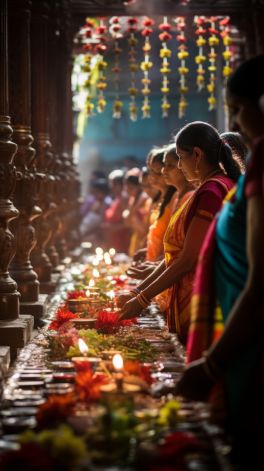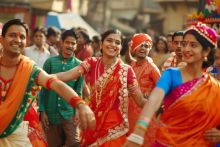
Tamil Nadu is a state of unparalleled cultural vibrancy due to its vast heritage temples, art forms, festivals and being the cradle of various dance forms. Have a glimpse at Tamil Nadu’s cultural heritage.

According to historical data Tamilakam region indicates a continuous history of human occupation for more than 3,800 years. The region was inhabited by Tamil-speaking Dravidian people. The cultural heritage of Tamilakam evolved from a diverse range of empires ruled the region over many centuries.
The region was reigned by many renowned kingdoms including the Sangam period (3rd century BCE to 3rd century CE) triumvirate of the Cheras, Cholas and Pandyas, the Pallavas (3rd–9th century CE), and the later Vijayanagara Empire (14th–17th century CE). European colonization began in the 17th century CE, and lasted for over two centuries.
Tamil Nadu boasts a vibrant tapestry of cultural festivals, some of which are harvest-related such as Pongal while some of the festivals are intricately linked with the myths and legends of the land. For instance, Thaipusam is a Tamil festival celebrated on the first full moon day of the Tamil month of Thai coinciding with Pusam star and dedicated to God Murugan.
Pongal, the harvest festival, is one of the most celebrated, lasting four days and honouring the Sun God and farm animals.
The Chithirai Festival is a festival that takes place at Madurai, which puts on a grand spectacle marking the celestial wedding of Lord Sundareswarar and Goddess Meenakshi.
The state has a rich cultural heritage steeped in history and myth and people of this land still preserve it with great fervour and passion.
Dravidian temple architecture of Tamil Nadu
The state is famous for its temple architectural styles and millions of pilgrims visit Tamil Nadu from all over the world every year. Dravidian architecture style of temple architecture defines the spiritual landscape of the state. The temples consisted of a central sanctum (garbhagriha) topped by pyramidal tower or vimana, porches or mantapas preceding the door leading to the sanctum and large gate-pyramids or gopurams on the quadrangular enclosures that surround the temple. Besides these, they consisted of large pillared halls and one or more water tanks or wells.
Murals &Fresco paintings adorn Tamilakam temples
Tamil paintings are usually centered around natural, religious or aesthetic themes. Sittanavasal is a rock-cut monastery and temple attributed to Pandyas and Pallavas which consist of frescoes and murals from the 7th century CE, painted with vegetable and mineral dyes in over a thin wet surface of lime plaster.
The murals on the Ranganathaswamy Temple at Srirangam and the Brihadeeswarar temple at Thanjavur are amazing examples.
One of the major forms of Tamil ancient painting is Thanjavur painting. Thanjavoor painting originated in the 16th century CE. In this visual art form, a base made of cloth and coated with zinc oxide is painted using dyes and then decorated with semi-precious stones, as well as silver or gold threads.
The musical heritage history of Tamilakam
The ancient Tamilakam region had its own system of music called Tamil Pannisai.
The Sangam literature, Silappatikaram from 2nd century CE states about music notes and instruments.
From the 9th century CE, Shaivite hymns Thevaram and Vaishnavite hymns Tiruvaymoli were sung along while musical instruments were played in the background.
There are many traditional instruments received from the region dating back to the Sangam period such as parai, tharai, yazh,and murasu. Nadaswaram, a reed instrument that is often accompanied by the thavil, a type of drum instrument are the major musical instruments used in temples and weddings.
Melam is from a group of percussion instruments from the ancient Tamilakam which are played during events and functions.
Carnatic music originated later from the region which included rhythmic and structured music by composers such as Thyagaraja, Muthuswami Dikshitar, and Shyama Shastri.
Villu Paatu is an ancient form of musical story-telling method where narration is interspersed with music played from a string bow and accompanying instruments.
Gaana is a combination of various folk music sung mainly in Chennai region of Tamil Nadu.
Tamilakam -the cradle of Bharatanatyam
Bharatanatyam is a major genre of Indian classical dance that originated from Tamil Nadu and reached global platforms through talented and renowned artists from the country. It is one of the oldest classical dance forms of India.
There are many folk-dance forms that originated and are practiced in Tamil Naadu.
Karakattam involves dancers balancing decorated pot(s) on the head while making dance movements with the body.
Kavadiattam is part of a ceremonial act of sacrifice, wherein the dancers bear a kavadi, an arch shaped wooden stick balanced on the shoulders with weights on both the ends.
Kolattam is a folk-dance form performed by women in which two small sticks (kols) are crisscrossed to make specific rhythms while singing songs.
Kummi is similar to Kolattam, with slight difference that hands are used to make sounds while dancing instead of sticks used in the later.
Mayilattam is another folk-dance form. In Mayilattam, dancers wear attires and outfits resembling the peacocks and peacock feathers and head dresses. They perform movements to various folk songs and tunes while trying to imitate the movements of a peacock.
Koothu is a form of theatre performance usually happening on streets. The play consists of dance along with music, narration and singing. The performers wear elaborate wooden headgear, special costumes with swirling skirts, ornaments such as heavy anklets along with prominent face painting and make-up. This art of Koothu is performed during festivals in open places and streets and it is dedicated to goddesses such as Mariamman or Draupadi with stories drawn from Hindu epics, mythology and folklore.
Bommalattam is a type of puppetry that uses various doll marionettes manipulated by rods and strings attached to them.
The themes are drawn from various Hindu scriptures such as the Puranas and epics and/with local folklore.
Cultural festivals of Tamil Nadu
The state of Tamil Nadu has been celebrating many cultural festivals commemorating its ancient pride and grandeur. Most of these festivals are connected to the epics and the divinity associated with the landscape.
- Chithirai Festival is a festival that takes place at Madurai, which puts on a grand spectacle marking the celestial wedding of Lord Sundareswarar and Goddess Meenakshi.
- Pongal
Pongal is a major and multi-day harvest festival celebrated by Tamils in the month of Thai according to the Tamil solar calendar (usually falls on 14 or 15 January). The harvest festival also has a sacred linking with Indian mythology as it dedicated to the Sun God .This festival is named after the ceremonial “Pongal”[ meaning -to boil, overflow] which is the traditional dish prepared from the new harvest of rice boiled in milk with jaggery offered to Surya.
Mattu Pongal is meant for celebration of cattle when the cattle are bathed, their horns polished and painted in bright colors, garlands of flowers placed around their necks and processions.
Jallikattu is yet another traditional event held during the Pongal festival period. In this event a bull is released into a crowd of people, and multiple human participants attempt to grab the large hump on the bull’s back with both arms and hang on to it while the bull attempts to escape. Although it is a scary event jeopardizing human lives and has claimed legal attention several times it part of the tradition of the state.
Karthikai Deepam is a festival of lights that is observed on the full moon day of the Kartika month, called the Kartika Pournami, [on the months of November or December].
- Aadi Perukku is a Tamil cultural festival celebrated on the 18th day of the Tamil month of Adi which pays tribute to water’s life-sustaining properties. The worship of Amman and Ayyanar deities are organized during the month in temples across Tamil Nadu with much fanfare.
- Panguni Uthiram is a festival marked on the purnima (full moon) of the month of Panguni and celebrates the wedding of various Hindu gods.
- Vinayaka Chaturthi is a festival of Lord Ganesha. It is celebrated with special temple poojas to pay respect to Lord Ganesha. On the fourth day after the new moon in the Tamil month of Avani, devotees start eleven days of celebrations by worshipping clay idols of the Lord. These idols will be installed outdoors in pandals or marquees. The legend linked with this festival is that it was on this day that Lord Shiva beheaded Lord Ganesh for refusing him entry into his abode. Lord Ganesh was guarding Lord Parvati while she was taking a bath. Later, Lord Shiva brought him back to life, by replacing his head with that of an elephant. Pran Pratishtha, Shodashopachara, Uttar Puja and Ganpati Visarjan are the four rituals associated with the festival. Grand celebrations are held at the Vinayaka temples on this day.
- Mahamaham
This bathing ritual is celebrated once in 12 years in the quaint town of Kumbakonam and it is a festival event attracting huge crowd.
The Mahamaham festival is a bathing ritual that is believed to cleanse one of all sins. The bathing takes place in the Mahamaham tank that is situated at the heart of the land of temples. The date and time for the celebration of this festival is calculated according to the astrological positions of planets.
There is a myth associated with this holy bath. It was the prayer by the holy rivers Ganga, Yamuna, Sarayu, Cauvery, Saraswati, Mahanadi and Narmada which paved way for Mahamaham bathing festival. These river goddesses prayed to Lord Bhrahma to get rid of the sins of theirs that occurred by humans washing in these rivers. As they prayed to Lord Brahma, he instructed them to take a bath in Mahamaham waters together so that they attain purity. Since that time, it is believed that the Mahamaham tank comprise of the waters of all the holy rivers and taking a dip in the tank is equivalent to taking a dip in all the holy rivers.
During the mahamaham festival Kumbakonam town bustles with celebration and the fervour of devotion. During the event the whole town glistens with lamps and vibrant colours.
- Natyanjali dance festival
Natyanjali is an annual classical Indian dance festival. It denotes to the dance festival at Chidambaram Nataraja temple. Originally, the festival was introduced at the Chidambaram temple, but nowadays it has been organized at many other temples in Kumbakonam, Thanjavur, Chennai, Nagapatinam, Mayavaram, Thirunallar, Thiruvanaikoil, etc.
This dance festival provides an opportunity for all dancers, from all over India, to perform and to pay their tribute to Lord Nataraja. It begins on the auspicious occasion of MahaShivarathiri. Many famous dancers from all over the country congregate and dance in the temple as an offering to Lord Nataraja on this occasion.
Other notable cultural festivals of Tamilnadu include Thaipusam, a spiritual celebration honouring Lord Murugan. Tamil Nadu also celebrates Navaratri & Deepavali festivals with its vibrance and fervour.
Chennai Sangamam is yet another big Tamil cultural festival held in Chennai every year with the noble purpose of rejuvenating the old village festivals , folk art forms and for encouraging artists from the remote hamlets of Tamil Nadu.
Location of Tamil Nadu
Coordinates: 11°N 79°E
Country India
Region South India
It is a south Indian state of India with many heritage spots.
For international travellers
Air ports in Tamil Nadu-
- Tiruchirappalli International Airport
- Chennai International Airport
- Coimbatore International Airport
- Madurai International Airport
written by dr sanjana p souparnika[ copyright]
References
- https://www.tamilnadutourism.tn.gov.in/photos/festivals
- https://www.southtourism.in/tamilnadu/festivals/index.php
- https://en.wikipedia.org/wiki/Tamil_culture
- https://www.culturalindia.net/indian-dance/folk-dances/south-india.html
- The Garland Encyclopedia of World Music South Asia: The Indian Subcontinent
- https://www.tamilnadutourism.tn.gov.in/plan-your-trip/airports
- https://www.tamilnadutourism.com/festivals/vinayaka-chathurthi.php



